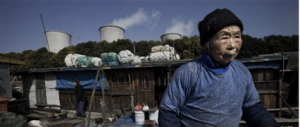China’s beleaguered lead-acid battery industry has suffered yet another blow – this one landing on American company Johnson Controls, regarded by industry insiders as a “model of health and safety”.
Since September 2, dozens of children in the Kangqiao area of Shanghai’s Pudong district have tested positive for excessive levels of lead in their blood. A statement from the Pudong Health Bureau said: “As of 3pm on September 20, healthcare authorities have confirmed lead poisoning in 32 children, 15 of whom have or are receiving in-patient treatment.”
While a small firm illegally assembling a tiny number of lead-acid batteries has received some of the blame, the main finger of suspicion has pointed at Johnson Controls’ wholly owned subsidiary Shanghai Johnson Controls International Lead-Acid Batteries, better known as Shanghai Johnson. Lead-acid batteries are mostly used in vehicles.
Several industry insiders interviewed by Southern Weekend said that they were incredibly surprised by the development. “Johnson Controls is the industry’s technological leader, and a model of health and safety,” one said.
In the latest setback for an industry already reeling from a fierce government reaction to a string of Chinese lead-poisoning cases earlier this year, it appears this role model may not be all it’s cracked up to be.
Speaking to Southern Weekend on September 20, Ju Chunfang, an investigator in the pollution prevention office at Pudong environmental protection bureau, confirmed that the facility had been temporarily closed: “On September 13, we sent them [Johnson Controls] an administrative order to temporarily halt production.”
Johnson Controls is the world’s largest manufacturer of lead-acid batteries. In 2005, it purchased Shanghai Deke International Lead-Acid Batteries and formed Shanghai Johnson – its first step into the Chinese market.
The company is located in Pudong New District’s Kangqiao Industrial Park, where the former districts of Pudong and Nanhui used to meet before the boundaries were redrawn. Kanghua village, where the poisoning occurred, lies among the factories here.
“Since March, we have required that health checks for children at nurseries and clinics include tests for blood-lead levels,” said Bai Yun, head of Pudong Health Bureau’s public health office.
Blood taken by pricking the children’s fingers was sent to Shanghai Adicon Medical Testing Centre. “Very quickly, they told us that two or three children had high levels of lead,” said Bai. Panic spread. In early September, some residents protested outside the township government. On September 8, the health authorities arranged for staff from Xinhua Hospital to take blood samples en masse – this time from the children’s veins.
“The youngest child was seven months old, the oldest eleven 11 years old,” continued Bai. “As of September 18, blood from 43 children from Kanghua had been tested at Adicon, with high lead levels detected in 33 of them – up to 897 [micrograms per litre]. Another 53 samples were tested at Xinhua Hospital, 29 of which were found to have high lead levels, the highest 535 [micrograms per litre].” The children’s families themselves gathered these figures and presented them to the Southern Weekend. They don’t understand how figures for both the lead levels detected and the number of children affected were lower at Xinhua Hospital than at Adicon.
The parents had to assume the worst. One hundred micrograms of lead in a litre of blood is considered high – over 700 micrograms and you’re talking about kidney damage, causing headaches, fainting, coma and even death.
Yan Chonghuai, head of the paediatric department at Xinhua Hospital, responded to concerns over the discrepancy in the figures: “It’s common medical knowledge that there will be a drop in levels between peripheral blood and venous blood. Peripheral blood tests are a first filter for blood-lead levels, but final diagnosis relies on venous blood. The skin absorbs lead, so peripheral blood often gives a false positive.”
According to Bai Yun, 15 children required in-patient care, while the rest were treated as out-patients. Of these, eight have been discharged after completing their first round of treatment, though they will have follow-up checks.
The problems at Shanghai Johnson have shocked the industry. “Workers at many large lead-battery makers in China still don’t have any protection, but measures taken at Johnson are perhaps the best,” said one environmental assessor, who preferred to remain anonymous.
Shanghai Johnson told Southern Weekend: “Our factory in China has world-class, cutting-edge pollution control systems, which are operated and maintained to the highest standards. Our investment in environmental-protection equipment ensures that our environmental performance meets the highest Chinese and global standards.”
Bai Yun confirmed that the company carries out health checks for workers annually, and that so far virtually no cases of high blood-lead levels have been found among employees.
In 2006, Shanghai Johnson’s factory was named a “national model for workplace health” by China’s Ministry of Health and the State Administration of Work Safety. It was the only battery manufacturer among the 56 firms honoured. “In a sense, Johnson is a role model for the industry. If it has problems, that’s going to do huge damage to the industry as a whole,” said one worried executive at a Zhejiang-based lead-acid battery manufacturer.
After a spate of lead-poisoning incidents in Zhejiang and Guangdong earlier this year, government authorities including the Ministry of Environmental Protection and the National Reform and Development Commission launched an industry crackdown. As of July 31, some 1,600 lead-acid battery manufacturers had been closed down or instructed to halt production while changes are made.
The sector already looks like it’s on its last knees. The incident at Shanghai Johnson may prove the final straw. So what has been going wrong at this supposed paragon of industry standards?
“The three big problems at Shanghai Johnson are: lack of control over emissions; exceeding production quotas [the company is told how much lead it is allowed to use] and an inadequate buffer zone [between the facility and the local population],” said an environmental assessment academic, who preferred to remain anonymous.
In June this year, the district environmental protection bureau carried out fairly rigorous tests on Shanghai Johnson’s air and water outlets and workshops, and found that emissions at four of 35 air outlets were in breach of regulations.
Ju Chunfang explained that, over the last few years, the state has been conducting trial clean manufacturing audits, and that last year an audit report for Shanghai Johnson was rejected. One of the reasons for this was an inadequate buffer zone around the facility.
Shanghai Johnson told Southern Weekend that, after large investments in environmental-protection equipment, the plant had reduced lead emissions from the mandated maximum of 323 kilograms per year in 1996 to 129 kilograms per year. But an anonymous industry insider said: “The figure for total emissions is derived from other data sets – if, for example, the production data provided by the company is faked, the accuracy of the overall emissions figure would be questionable.”
The risks of exceeding production quotas are even worse. An informed source told us that Johnson Controls has been gradually expanding production ever since it purchased its first facility in 2005. In 2009 and 2010, the company built new plants in Zhejiang, on the east coast, and Chongqing in western China. It has also quietly upped its Shanghai operations.
“Without environmental protection bureau approval, the company added an extra production line four years ago. Normally, we run three lines, but if the bureau comes they stop one – and start it again once they’ve gone. It’s an open secret among the workers here,” said one Johnson employee. Three production lines alone quickly used up Johnson’s lead allocation.
Ju Chunfang explained that, during the MEP industry crackdown, officials discovered that Johnson was using more lead than it was authorised to. “We told them straight: you only use how much we tell you to use,” said Ju. In July, Shanghai Johnson finally shut down the “invisible” production line. But during the recent poisoning incident, the environmental authorities have again discovered excessive use of lead.
On September 13, the environmental protection bureau ordered Johnson to halt production while it investigates the Kangqiao lead pollution incident and confirms the source of the poisoning. “They weren’t happy about it, but in the end they cooperated and closed the factory,” said Ju.
Remedial work is under way. In mid-September, Shanghai’s environmental protection bureau ordered checks on all firms working with lead as part of “high-pressure monitoring” of lead-acid battery and lead recycling firms.
This article was first published by Southern Weekend, where Lu Minghe is a reporter.
Homepage image from Southern Weekend shows a victim of a lead poisoning incident in Zhejiang province in June 2011. His medical results show blood-lead levels four times the standard.





